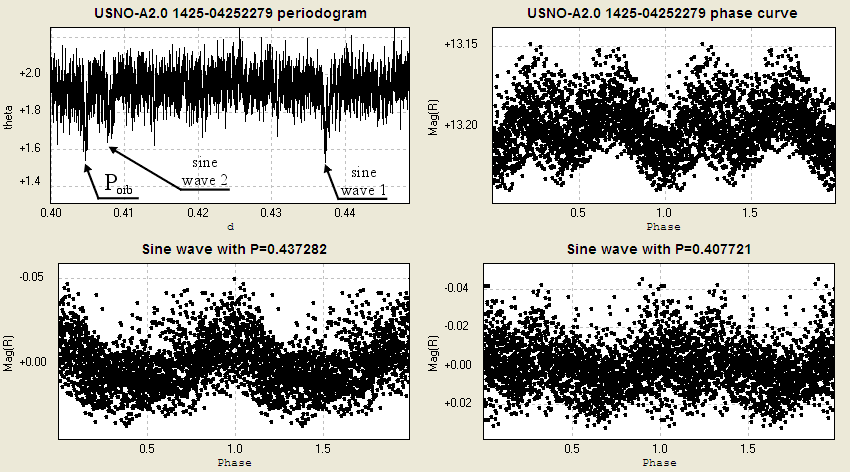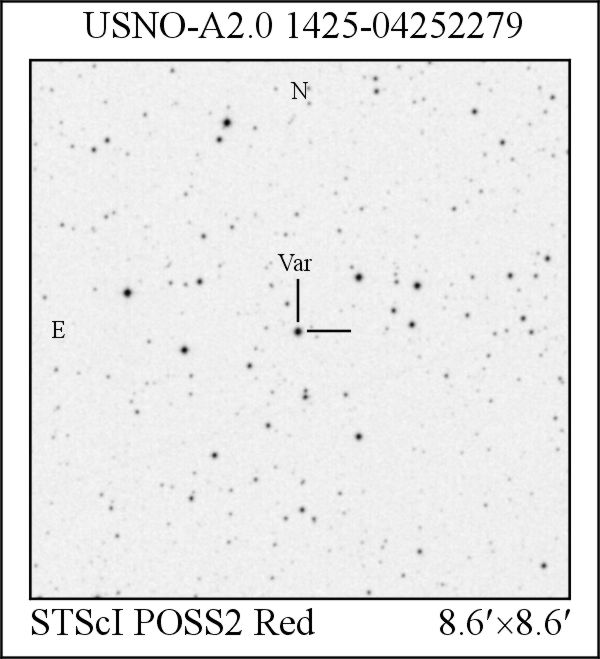"Peremennye Zvezdy",
Prilozhenie,
vol. 11, N 21 (2011)
Prilozhenie,
vol. 11, N 21 (2011)
USNO-A2.0 1425-04252279: a New Eclipsing RS CVn Star with Spot Activity of Both Components
V. Solovyov#1, A. Samokhvalov#2, B. Satovskiy#3
#1. Kazan Federal University, Russia;
#2. Surgut, Russia;
#3. Astrotel Observatory, Karachay-Cherkessia, Russia
#2. Surgut, Russia;
#3. Astrotel Observatory, Karachay-Cherkessia, Russia
Received: 9.03.2011; accepted: 23.05.2011
(E-mail for contact: solo.vya@gmail.com, sav@surgut.ru, bs25@mail.ru)
| ||||||||||||||||||||||
Remarks: | |||||||||||||||||||||||
| During observations of a field in Perseus, we discovered variability of USNO-A2.0
1425-04252279. It is a low-amplitude eclipsing variable star demonstrating probable
spot activity
of
both components of the binary system. Our observations were carried out at the Astrotel–Caucasus
observatory, located at the Astronomical station of the Kazan Federal university,
using the 300-mm Ritchey–Chretien telescope, equipped with an unfiltered Apogee
Alta
U9000 CCD camera. A total of 2316 images with 5-minute exposures were obtained on
JD 2455080
– 2455519. For basic reductions for dark current, flat fields, bias, and for
removing
cosmic-ray hits, we used IRAF routines. For photometry of the new variable star,
we applied
VaST software by Sokolovsky and
Lebedev (2005). The comparison star was USNO-A2.0 1425-04237176 = USNO-B1.0 1473-0129296
(α=03h15m37s.41, δ=+57°19′ 36″.5,
J2000; 2MASS),
R1 = 14m.33, R2 = 14m.60
(USNO-B1.0). Unfiltered magnitudes were calibrated using the comparison star, assuming
Rcomp = 14m.465. The coordinates of the variable star were
drawn
from the 2MASS catalogue (Skrutskie et al. 2006).
USNO-A2.0 1425-04252279 is located at the distance of 15″.7 from the X-ray source 1RXS J031707.9+572942, which is larger than the position error of the source (12″), but its hardness ratio HR1 = –0.03 ± 0.29, typical of chromospherically active stars, and its character of variability allow us to assume that the star is related to the X-ray source. Using Peranso software, we find the orbital period of the binary and then, removing the signal with Porb, find two sine-wave variations, presumably reflecting the spot activity of both components of the system. The orbital period and the sine-wave periods, with corresponding epochs of primary extrema, are given in the table below.
All times in the table are expressed in the Terrestrial Time (TT) in accordance with IAU recommendations (resolution B1 XXIII IAU GA). This star is the shortest-period RS CVn star when compared to chromospherically active binary stars in the third version of the catalog of chromospherically active binaries (Eker et al. 2008). The effect of binarity on stellar activity is an interesting problem, and close binaries like our new variable can help to understand it. We hope that the present study will stimulate new observations of this interesting, very active, and relative bright star. | |||||||||||||||||||||||
| References: | |||||||||||||||||||||||
| Eker, Z., Filiz Ak, N., Bilir, S., et al., 2008, Monthly Notices of the Royal Astron.
Soc., 389, 1722
Renson, P., 1978, Astron. Astrophys., 63, 125 Skrutskie, M.F., Cutri, R.M., Stiening, R., et al., 2006, Astron. J., 131, 1163 Sokolovsky, K., Lebedev, A., 2005, in 12th Young Scientists' Conference on Astronomy and Space Physics, Kyiv, Ukraine, April 19-23, 2005, eds.: Simon, A.; Golovin, A., p.79 |
Light Curve
The Renson (1978) periodogram with three peaks: the orbital one and two periods of sine waves, wave 1 and wave 2; three phase curves of USNO-A2.0 1425-04252279 : the eclipsing light curve and the curves for the two sine waves. Finding Chart 
Finding chart, based on POSS II red image. Data Source |